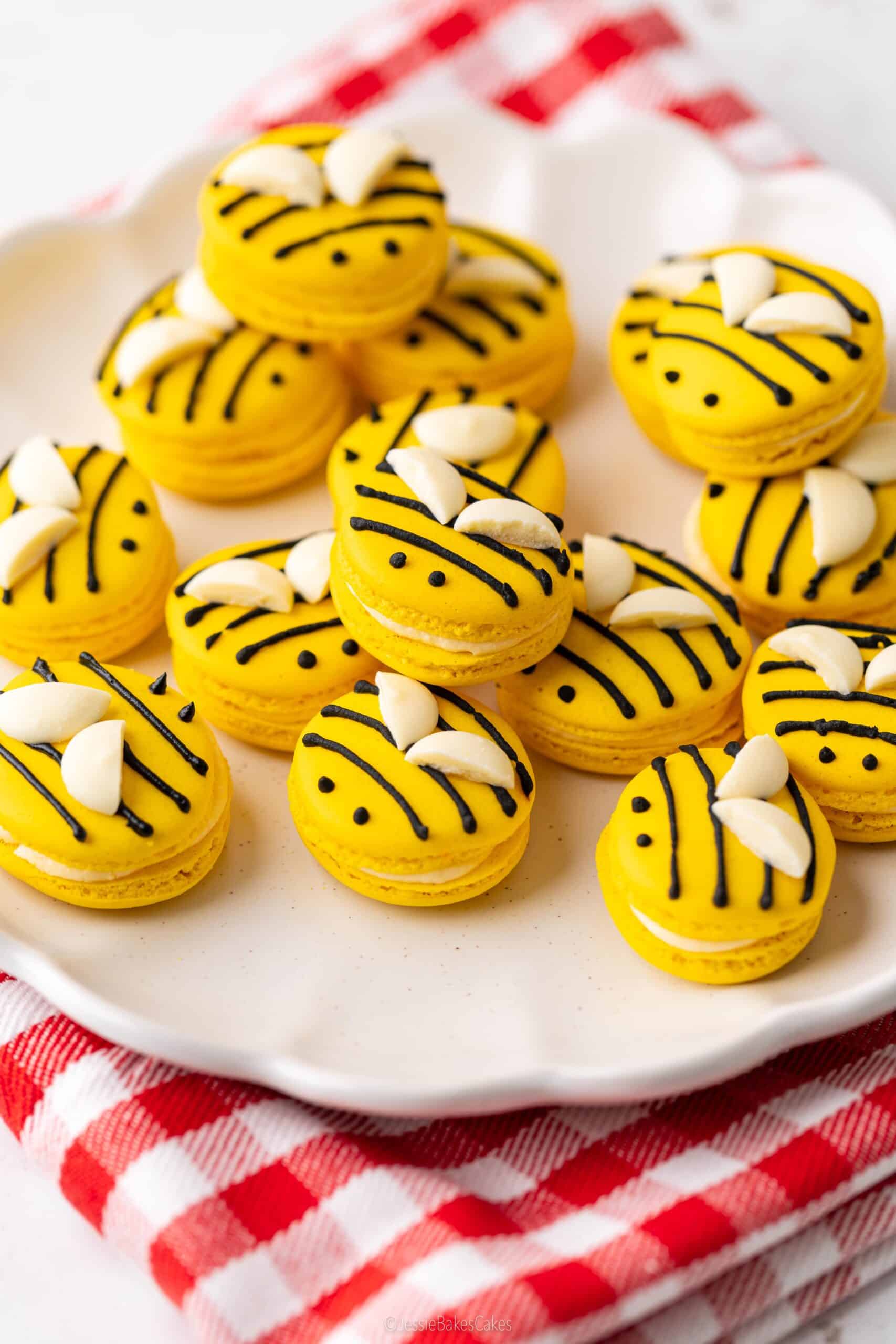
Bee Macarons
Whether you’re hosting a garden party or just fancy a fun summer bake, these little Bee Macarons filled with honey buttercream will definitely steal the show!
Rate this Recipe
Print Pin Rate this RecipeServings:
Ingredients
For the macaron shells:
- 100 grams Icing sugar
- 100 grams Ground almonds
- 100 grams Egg whites approx. 3 medium eggs
- 0.5 teaspoon Cream of tartar
- 100 grams Caster sugar
- 1 teaspoon Vanilla extract
- Yellow food colouring gel or liquid (not oil-based!)
For the honey buttercream filling:
- 75 grams Unsalted butter or baking block room temperature
- 150 grams Icing sugar
- 1 teaspoon Honey
- 1 tablespoon Milk
For the bee decoration:
- Black writing icing tube
- 30 grams Milkybar Buttons I used one treat-sized bag of buttons
Instructions
Start by making the macaron shells:
- Sift the icing sugar and ground almonds together three times over into a medium bowl. If any large almond bits remain in the sieve, discard them (don’t force them through). Set aside.100 grams Icing sugar, 100 grams Ground almonds
- Place the egg whites in a very clean mixing bowl – any grease or yolk will prevent them from whipping properly. Whisk on medium speed until they become foamy and white (~3 minutes).100 grams Egg whites
- Add the cream of tartar and whisk to combine. Then begin adding the caster sugar 1 tablespoon at a time, whisking continuously. This gradual approach helps stabilise the meringue. Once all the sugar has been added, turn the speed up to high and continue whisking until you reach soft peaks (~5 minutes). The meringue should form peaks that just droop at the tip.0.5 teaspoon Cream of tartar, 100 grams Caster sugar
- Add the vanilla extract and a few drops of yellow food colouring (start small—you can always add more). Continue whisking until you reach very stiff peaks (~5 minutes). The meringue should be glossy and hold its peak firmly when the whisk is lifted.1 teaspoon Vanilla extract, Yellow food colouring
- Add one-third of the sifted dry ingredients to the meringue. Using a silicone spatula, gently fold it through by scraping around the bowl and cutting through the centre in a figure-of-eight motion. Repeat with the next third, and then the final third. Keep folding until the mixture flows off the spatula in a slow, thick ribbon-like consistency. You should be able to draw a figure 8 with the mixture dripping off your spatula without it breaking.
- Transfer the mixture to a piping bag fitted with a round nozzle (or snip a medium hole if not using a tip). Pipe 1-inch rounds onto a baking tray lined with baking paper. Space them at least 2cm apart. Tap the tray firmly on the worktop a few times to release air bubbles and use a toothpick to pop any that rise to the surface.
- Leave the piped shells to rest at room temperature for at least 1 hour, or until they’re no longer tacky to the touch. A dry skin should form – this helps the macarons rise evenly in the oven without cracking.
- Preheat the oven to 120°C fan (140°C conventional). Bake the macarons on the middle shelf for 15-20 minutes, turning the tray halfway if needed. The macarons are ready when they’ve developed “feet” (the frilly base) and are sturdy when lightly pressed. If the base moves at all, bake for a further 2 minutes and check again. Leave to cool completely. Then use an icing spatula or knife to scrape the shells away from the baking paper.
Make the honey buttercream:
- Beat the butter until soft and fluffy.75 grams Unsalted butter or baking block
- Add the icing sugar, honey and milk. Beat well until the buttercream is smooth and combined.150 grams Icing sugar, 1 teaspoon Honey, 1 tablespoon Milk
- Spoon the buttercream into a piping bag fitted with a round piping nozzle.
Decorate the bee macarons:
- Use the black writing icing to pipe stripes across half of the macaron shells, then add two small dots for the bees’ eyes.Black writing icing tube
- Snap the Milkybar buttons in half and gently press them into the striped shells to create wings.30 grams Milkybar Buttons
- Pipe a swirl of honey buttercream onto the plain macaron shells, then sandwich with the decorated tops to complete your bee macarons. Enjoy!